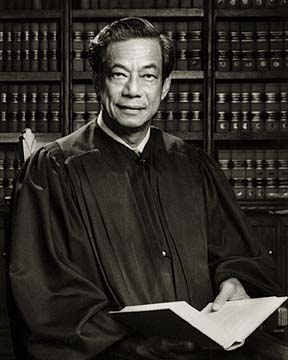

William S. Richardson

Judge helped keep
By Lori Tighe
Hawaii for the people
Star-BulletinAS chief justice of the Hawaii Supreme Court from 1966 to 1982, he drew a line in the sand in favor of the public.
William S. Richardson, "a local boy" of Hawaiian-Chinese-Caucasian ancestry, gave the public greater rights to the beaches and waters of the state.
Richardson swept aside a century of legal precedents in the field of property rights and determined what's good for the mainland isn't necessarily good for Hawaii. His activist court drew criticism from the legal profession and raves from the public.
In the court's own words, "The western concept of exclusivity is not universally applicable in Hawaii."
The Richardson court helped expand native Hawaiian rights to use private property. It gave the public more access to private lands to beaches. It awarded new land created by lava flows to the state, instead of to nearby property owners. It broadened the rights of citizens to challenge land court decisions.
And in its most controversial decision, the Richardson court reached back into the history of Hawaiian monarchy and duplicated how native kings determined water rights. In a stunning decision, his court declared that water that had been fought over by two Kauai sugar plantations for 50 years belonged to neither of them.
The public owned it, the court ruled.
Richardson graduated from Roosevelt High School and the University of Hawaii, and earned his law degree from the University of Cincinnati. He served in World War II with the 1st Filipino Infantry Regiment.
He fought for statehood, served as Hawaii Democratic Party chairman from 1956 to 1962, and was lieutenant governor under Gov. John A. Burns before becoming chief justice. After his term as chief justice, he served as a Kamehameha Schools/Bishop Estate trustee from 1983 to 1992.
The University of Hawaii law school is named in his honor, and now echoes his rulings in its classrooms.
The Big Five

Big 5 companies were
By Rob Perez
all-powerful
Star-BulletinTHEY were called the Big 5 -- for good reason. For decades they essentially ran Hawaii. In politics or business their influence was second to none. Major changes did not happen without their blessing.
Castle &
Cooke. Alexander & Baldwin. C. Brewer & Co. Amfac. Theo H. Davies & Co.
From the late 1800s to the mid-1900s, these five companies, which traced their roots to the state's sugar industry, represented the single most dominant force in Hawaii.
Cooperation, not competition, was their mantra, creating what many considered all-too-cozy relationships that led to stellar profits for the companies but high prices for consumers.
Not surprisingly, executives of the Big 5 came from the same mold. They were white. Republican. Male.
They moved in the same corporate and social circles.
It was not uncommon for the executives to serve on the boards of the same companies.
Such close ties were considered harmful to market competition, eventually leading legislators -- mostly Democrats -- to pass a law banning so-called interlocking directorships.
In the political arena, the Big 5 influence was impressive and, at times, illegal. Their plantation managers used to hang pencils from the ceilings above voting booths so the managers could tell from the way the string moved how people voted.
An "improper" vote resulted in threats of retaliation.
The influence and reach of the Big 5 began to dissipate at about the time of statehood, particularly as Hawaii's economy broadened from its mostly agricultural base.
Still, the companies continue to be major players in some markets.
They are among the largest companies in Hawaii, with A&B near the top of the list. Several are among the largest private landowners in the state.